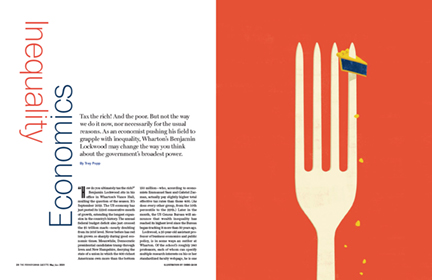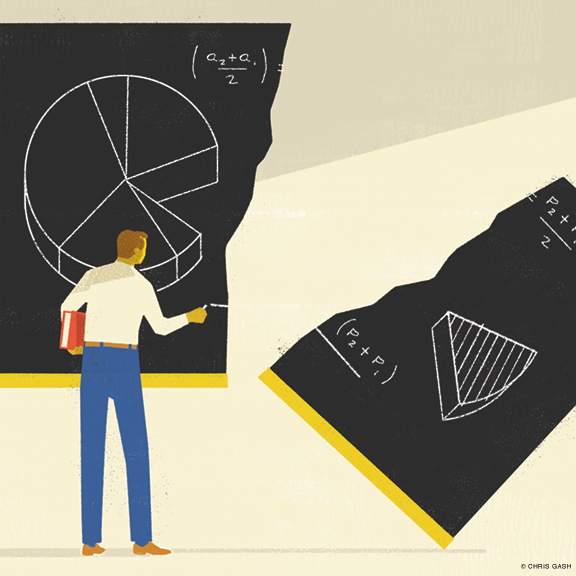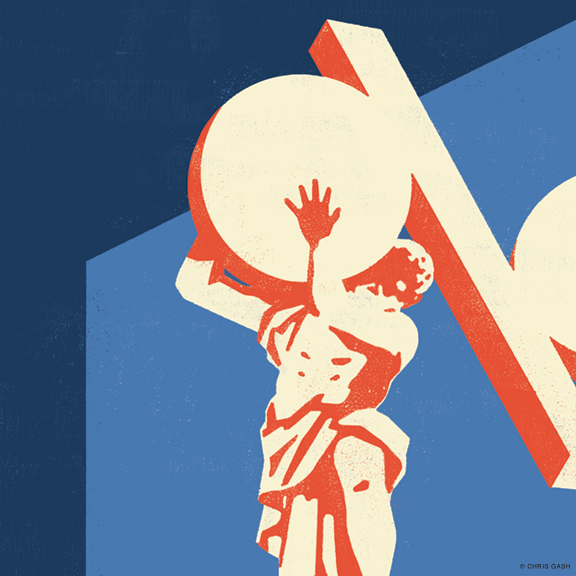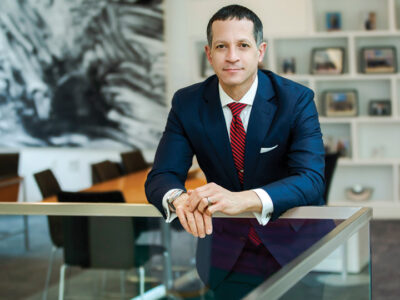
Tax the rich! And the poor. But not the way we do it now, nor necessarily for the usual reasons. As an economist pushing his field to grapple with inequality, Wharton’s Benjamin Lockwood may change the way you think about the government’s broadest power.
BY TREY POPP | Illustration by Chris Gash

“How do you ultimately tax the rich?”
Benjamin Lockwood sits in his office in Wharton’s Vance Hall, mulling the question of the season. It’s September 2019. The US economy has just posted its 123rd consecutive month of growth, extending the longest expansion in the country’s history. The annual federal budget deficit also just crossed the $1 trillion mark—nearly doubling from its 2016 level. Never before has red ink grown so sharply during good economic times. Meanwhile, Democratic presidential candidates tramp through Iowa and New Hampshire, decrying the state of a union in which the 400 richest Americans own more than the bottom 150 million—who, according to economists Emmanuel Saez and Gabriel Zucman, actually pay slightly higher total effective tax rates than those 400. (As does every other group, from the 10th percentile to the 99th.) Later in the month, the US Census Bureau will announce that wealth inequality has reached its highest level since the Bureau began tracking it more than 50 years ago.

Lockwood, a 35-year-old assistant professor of business economics and public policy, is in some ways an outlier at Wharton. Of the school’s roughly 240 professors, each of whom can specify multiple research interests on his or her standardized faculty webpage, he is one of just two who lists inequality. He also has a penchant for attacking economic questions from unconventional angles. Which is what he’s doing now.
How do you tax the income of top earners? When economists face that question, Lockwood explains, they typically focus on a concept familiar to anyone who took Econ 101: the elasticity of the labor supply. Someone who faces a marginal tax rate of 35 percent might be willing to work 60 hours a week; but raise the rate to 45 percent and she might decide it’s only worth working 55 hours instead. The higher levy might bring in more revenue—but five hours of work have disappeared. Though that might be a boon for the worker’s spouse, to the economy it’s lost productivity. Put three economists in a room and you might get three opinions on how elastic the supply of labor truly is, but they’ll probably agree that lost productivity is really the thing you want to minimize.
“But when you look at the debates in society about how heavily the rich should be taxed,” Lockwood remarks, “that sort of efficiency cost doesn’t seem to be the thing that people are often arguing about. Instead, they’re arguing about what the rich are actually doing with their time, for society.”
Reduced to their opposite poles, the views are familiar. “One is that the rich are these job creators—these engines of economic growth that create lots of benefits and employ people and are something to be encouraged,” he says. “The other is that there are these rent-seekers who are exploiting the talents and labors of people below them in the pecking order, and kind of absconding with the benefits—the benefits of society.
“And that,” he adds, “sounds like a pretty different model for how you would decide how much to tax the rich.”
Political bickering dominates this discussion in the US. But what if you took the underlying ideas seriously? After all, if Jane Q. Citizen cares more about Richie Rich’s social impact than his utility-maximizing response to a certain marginal tax rate, shouldn’t an economist in a democratic republic take that into account? Lockwood thought so. So he and two colleagues—Charles Nathanson of Northwestern’s Kellogg School of Management and E. Glen Weyl of Microsoft Research—tried to bring some “economic formalism” to the debate.
They started out with the common-sense proposition—supported by economic research—that people in some professions are paid less than their actual value to society. “For example,” Lockwood says, “there’s some nice evidence that if you replace a bad teacher with an average one—not necessarily a terrific one, but just one in the middle of the pack—that raises the future salaries of the classroom of kids that they’re teaching by about $250,000 a year” across all of those pupils. “Well, that suggests that teachers are probably adding far more value to the economic pie than they receive in compensation.” Basic medical research, he adds, creates even larger spillover benefits that enrich society as a whole.
Meanwhile, other folks make great gobs of money to perform work of negligible or questionable social value. “Think about two big firms that are fighting over a fixed resource—an oil field, say—each with its army of lawyers,” he says. “Well, that’s a lot of compensation that’s being spent on a zero-sum fight” that won’t change the value of the underlying resource.
Which amounts to a different sort of waste—or lost opportunity, at any rate. Over the long haul, five extra hours a week at a lab bench might yield a novel treatment for Alzheimer’s—or, more modestly, an incremental advance in fuel-efficient engines that lowers everyone’s cost of travel. But five extra hours fighting over drilling rights doesn’t change the size of the contested oil deposit. The same goes for financial traders trying to beat the market; their profits come at one another’s expense, not through any fundamental change they bring about in the value of the assets they buy and sell. “It’s extremely important to have well-functioning financial markets,” Lockwood is quick to emphasize, but past a certain point, each additional investment banker is economically redundant. If 1,000 bond traders are enough to provide sufficient liquidity in a market, society gains little if another 1,000 join their ranks.
Indeed society may end up the poorer for it—especially if those superfluous bond traders had otherwise gone into something like teaching or medical science. Which turns out not to be an idle worry. Take the career choices of contemporary Penn graduates. According to Penn Career Services data reported a couple years ago in the Daily Pennsylvanian, of the students entering full-time jobs after graduation in recent years, nearly half have gone into finance or consulting. As Lockwood and his colleagues noted, there’s little mystery why. Among US multimillionaires, 18 percent work in finance while only 1 percent are professors or scientists.
But it wasn’t always this way. “Career choices are highly sensitive to changes in compensation,” the economists wrote in the Harvard Business Review in 2017, and “as salaries in finance professions rose sharply from 1980 to 2005, the share of workers in investment banks, hedge funds, and similar financial establishments more than doubled.”
That skew, they noted, could amount to a “severe misallocation” of what is arguably a nation’s most valuable asset: its talent pool. Society’s brightest members, in other words, are not being put to their best uses. (And this can be a sort of double loss, given that one of the most common regrets cited by white-collar professionals is having opted for high-paying but ultimately dissatisfying jobs.)

Pay varies in any market economy. Schoolteachers aren’t going to outearn oil-industry lawyers anytime soon. But countries could use income taxes to put a finger on the scale. Lockwood wondered what that might look like. What if you jettisoned the pretense that every kind of labor has equivalent social value, and instead designed a tax code with the single-minded goal of encouraging talented workers to pursue socially beneficial careers? Going further, what if you didn’t even care about some of the classic rationales for taxation, like funding safety-net programs or redistributing money from the haves to the have-nots? How would you tax the rich (and everybody else) then?
The most obvious answer would be to set different rates for different professions—rock-bottom taxes for teachers, for instance, and punitive ones for hedge fund directors. But even if such blatant discrimination were legally tolerable, hedge funders would soon rebrand themselves as “financial educators,” and so on, to escape the higher toll. So Lockwood and his colleagues modeled a profession-agnostic tax structure.
First they surveyed the research literature to estimate the positive or negative spillovers (externalities, in economic jargon) for various classes of skilled labor. Engineering and scientific research, for instance, are widely thought to have positive externalities. The glut of financial workers, and to a lesser degree legal professionals, appears to “exceed the social optimum”—leading to negative externalities. And many fields—like sales, the arts, real estate, management consulting, IT professionals—are judged to be a wash. (Which is to say, people in those fields tend to earn “approximately their marginal product”—i.e. neither more nor less than the value they generate, creating no net spillovers in one direction or the other.)
Armed with those estimates, along with some informed (if also admittedly uncertain) assumptions about the underlying distributions of skills and personal preferences in the population, Lockwood’s group used standard economic methods to calculate a marginal tax schedule that would maximize social welfare. The result was intriguing—partly because it didn’t line up neatly with the reigning prescriptions on either end of the current American political spectrum.
For one thing, the rich wouldn’t pay that much more than they’re used to paying. The marginal rate on income over $1 million worked out to 37 percent. That’s within a few points of what it’s been for the last 30 years. Similar marginal rates held for income above $150,000. But below that level, Lockwood’s model prescribed dramatically lower rates. Income between $100,000 and $150,000 would be taxed at 16 percent—and everything lower would face negative rates, which is to say, tax credits. The upshot was that a worker making $138,000 per year would pay exactly as much as someone with no income at all: zero. Everybody in between would get a check from the IRS, for something on the order of 3 to 8 percent of earned income.
The authors then compared their model to two alternatives: a simplified version of the actual income tax structure that was in place in 2005, and a laissez-faire simulation featuring no income taxes at all. This result was mixed. Their hypothetical system increased per-capita utility by $815—or 1.2 percent—relative to the laissez-faire scenario, and $503—or 0.8 percent—compared to the actual status quo. Which is better than no improvement at all, perhaps, but a far cry from the estimated social returns of directly subsidizing research. The authors concluded that if the government taxed researchers at -392 percent (which is to say, quadrupled their salaries, perhaps through the National Science Foundation), almost 10 times as many workers would enter those fields, creating positive spillovers that would drive broad social gains of 35 percent per capita. For an economy that hasn’t beaten a 3 percent annual growth rate for the last 15 years, that’s real money.
“This was to some extent a negative result,” Lockwood says, about the hypothetical tax structure, “in the sense that we could show that the benefits of just explicitly targeting certain professions would be way, way bigger.”
Yet the “negative result” revealed some counterintuitive insights. For instance, “even without any concerns about redistribution,” Lockwood points out, “it turns out that you would still [want to] have a moderately progressive tax.” Another takeaway relates to a stubborn feature of much tax-related punditry: the widespread insistence that modest changes in the top marginal income-tax rate can dramatically influence how skilled workers choose to spend their professional lives.
This insight stemmed from the authors’ analysis of why, exactly, their hypothetical tax’s impact would be so small. The likely reason, they concluded, was that it simply wouldn’t tilt potential after-tax earnings dramatically enough to change that many people’s career choices. It would modestly reduce the share of workers in negative-externality professions like finance and law, expand the share in engineering and research, and probably drive many workers toward careers with limited or no impact on economic social welfare at all. “However, none of these changes are very large,” they wrote, “and the broad allocation of talent stays the same.”
What that suggests, they inferred, is “that historical tax reductions are unlikely to have played a large role in the shifts in talent allocation.” To test that conclusion, they compared the distribution of today’s skilled workforce to that of 1980—i.e. the “pre-Reagan” era when the top marginal rate was 70 percent. They determined that although pre-Reagan tax rates depressed overall social welfare compared to today’s status quo—indicating that very steep progressive tax schedules indeed have drawbacks—the allocation of talent has been remarkably stable. So next time you hear a pundit claim that bumping the top marginal rate up (or down) by 5 percent will trigger economy-threatening idleness (or growth-juicing hustle) in the upper echelons of the labor force, take it with a grain of salt.
For a patently speculative theoretical exercise that generated a “negative result,” the paper is notable for the clarity and topicality of its take-home message.
“This might be one reason to have the income tax be a bit progressive,” Lockwood says, “even if you’re not trying to redistribute wealth.” In the real world, he adds, most people do have some aversion to inequality, and support the use of taxes to ameliorate it. Which would recommend a “hybrid model” featuring “some earned-income-tax-credit kind of support through the working class, then an increase in tax rates that are sort of progressive up toward the top of the income distribution.” Either way, their findings amount to a “huge argument for doing things like increasing NIH and NSF funding, and creating merit pay and boosting the salaries of teachers—basically doing things to try to draw people into those professions specifically, given what we seem to know about them.”
And with that, the unconventional economist pivots toward a topic that interests him just as keenly: how, ultimately, do you tax the poor?
Benjamin Lockwood grew up in northern Idaho in a timber-frame house his parents built the year he was born. They were “back-to-the-land hippies” who raised Benjamin and his sister, Julia, off the power grid, about 50 miles from the Canadian border, among neighbors whose common bond was everyone’s distance from the American mainstream. “The NRA folks and the hippies did ice cream socials together,” Lockwood recalls, musing on the ideological diversity that lurked beneath the racial homogeneity.
His father was a building contractor; his mother worked at a local hospital. Neither went to college, but they fostered an intellectual atmosphere that, in hindsight, might as well have been custom-designed to produce a public-spirited economist with a penchant for crunching giant data sets. The nearest grade school was a 40-minute drive, “but my parents were very committed to the idea of public education,” so there was no home-schooling for the Lockwood kids. In the off hours they had considerable room to roam. Between 4-H, the Boy Scouts, and the simple sprawling beauty of Northern Idaho, Benjamin spent plenty of time hiking, skiing, and sailing. But his mother policed some boundaries with “frustrating” vigor.
“She had a very statistically validated sense of what the risks to kids were, because she saw people coming into the emergency room,” Lockwood recalls. “So one thing I could never do was run with a sucker in my mouth—because, like, that is the thing that actually brings kids into the ER.” Adolescence brought other prohibitions, “like riding in cars while my friends were driving them.” His view of such restrictions was precisely that of every teenager who has walked the modern earth. Now that he’s in the utility-maximization business—and a parent in his own right—he calls it “a very reasonable Bayesian policy for you to have for your kids if you’re trying to keep them safe.”
A similar sensibility animates Lockwood’s research into a topic that has growing relevance around the world, and particularly in Philadelphia: sugar-sweetened beverage taxes (SBT). In 2016, Philadelphia became the first major US city to enact one, imposing a 1.5-cent-per-ounce levy on sweetened beverages ranging from fountain soda to “sports drinks” to bottled sweet tea. It sought to achieve two goals: discourage the overconsumption of beverages known to harm health (mainly through weight gain, type 2 diabetes, and cardiovascular disease); and raise money to expand pre-kindergarten programs and improve city parks and recreation centers.
The issues it raised scratched Lockwood right where he itched. “I don’t draw a bright line between the tax code and other sorts of policy realms,” he says. “In most cases policies are designed with one or two kinds of goals in mind. One is to change people’s behavior for some reason, and the other is to provide some sort of a safety net, or redistribution [to] support people who are less fortunate.” SBTs had both elements, but—as the soft drink lobby has vociferously argued—the tax fell heaviest on poor consumers. Not only does any flat-rate consumption tax hit thin wallets harder than thick ones, but in America poor people tend to drink more sugar-sweetened beverages than wealthier ones.
In a series of papers in the Journal of Economic Perspectives, the Quarterly Journal of Economics, and Science, Lockwood and several collaborators (Hunt Allcott, Dmitry Taubinsky, and Anna Grummon) presented the most complete analysis to date of the trade-offs involved. The upshot is that SBTs are indeed regressive. “They make soda, which is consumed at higher rates among the poor, more expensive. And so in that sense it takes money away from poor consumers,” he summarizes. But that’s not the whole story, because empirical evidence indicates that those same consumers respond to the tax most markedly, and so would expect to reap disproportionate benefits.
“By changing the profile of soda consumption,” Lockwood says, a well-designed SBT “reduces diabetes and obesity more among poorer households than among richer households. And that is a sort of progressive benefit.”
Of all the ways one might tax the poor, in other words, soda taxes seem like a pretty attractive one.
Drilling down, Lockwood and his colleagues served up a series of recommendations for policy makers. They pegged the “socially optimal” SBT at between 1 and 2 cents per ounce—but recommended that taxing actual grams of sugar, rather than volume of liquid (as has mostly been the case), would substantially amplify the tax’s benefits. A nationwide SBT, they estimated in Science, would cut obesity rates by over 2.5 million adults and reduce the number of new type 2 diabetes cases by 47,000 people per year. Accounting for health care system savings, consumer surplus losses, and tax revenues, they estimated that an optimal SBT would produce a net economic gain of about $1.8 billion per year.
Lockwood acknowledges the philosophical objections to this kind of nanny state approach.
“If you try to correct every mistake that people could possibly make,” he says, “that may give the government license to be overly intrusive … Multiple different policymakers will all have their own story for how they’re going to come along and be your savior” by taxing your guilty pleasure or trying to nudge you toward some salubrious habit. People who contend that this is not a game the government should be playing have a valid concern. Lockwood sees his role as to try to answer it. “In my mind, that is more of a rationale for having good, clear, sound policy analysis that justifies these kinds of policies, with a lot of rigor and peer review.”
That gels with some of the more subtle policy recommendations in these papers. For instance, the authors urge policymakers not to focus single-mindedly on minimizing sugar consumption. “The way to maximize health is to ban any sugary or fatty food or drink, including sugary drinks, red meat, and dessert,” they observe. “Such a ban would preclude any enjoyment that people get from eating steak or dessert, and it’s not clear where to draw the line on what foods or drinks to ban.”
The proper aim, they maintain, is less draconian: to focus instead on “counteracting externalities and internalities”—that is, empirically striking an optimal balance between health-related outcomes; losses imposed on consumers, producers, and sellers via the distortion of spending decisions; and government revenue. “Unhealthy behaviors do not necessarily merit policy intervention, as they could simply reflect the fact that people enjoy eating steak and dessert,” they write. “Sin taxes are justified only to the extent that they offset” harms that are not otherwise accounted for in the transaction price of the good in question. (A 25-year-old who pays a dollar for a soda three times a day can be assumed to have priced in the value of his immediate gratification, but evidence from behavioral economics suggests that he has not factored in more distant potential costs of that habit—like the possibility that he’ll have to spend 12 hours a week in a dialysis clinic in his 50s.)
A corollary recommendation is to target policies to reduce consumption among people among whom the potential harms are greatest. So if the health toll of sugary beverages falls most heavily on children, for instance—“perhaps due to limited self-control, or because their consumption generates lifelong habits—then very high taxes or bans on sugar-sweetened beverages in schools may be justified.”
In many ways that epitomizes the central aspect of Lockwood’s approach to economics: an appreciation for heterogeneity.
“The classic economic approach was to use a ‘representative agent model,’” Lockwood explains, where “you would have one representative US household that makes $60,000 a year or whatever, and has $60,000 or $70,000 worth of wealth, and 30 percent of that is financial and the other 70 percent is their home equity. But of course that doesn’t represent any particular household, right? That just comes out of the averages.
“That’s a useful way to think about some types of problems,” he continues, “in part because these kinds of models are relatively easier to solve than models where you have lots of different little agents … But it’s not a useful way to think about lots of problems that are really pressing from a policy perspective, when you’re thinking about questions of poverty or questions of inequality.”
Questions of inequality have elicited something like an allergic reaction among mainstream Anglo-American economists. “Of the tendencies that are harmful to sound economics, the most seductive, and in my opinion the most poisonous, is to focus on questions of distribution,” declared Robert Lucas Jr., a 1995 Nobel laureate widely regarded as the most influential macroeconomist of his generation.
But a new cohort of economists is beginning to challenge that stance. Thomas Piketty, Emmanuel Saez, and Gabriel Zucman are in the vanguard, along with Raj Chetty—who was one of Lockwood’s doctoral thesis advisors at Harvard.
“There’s been an evolution,” Lockwood says, “toward doing a better job of empirically analyzing the differences within the population, rather than just kind of representing the representative agent. And incorporating that kind of heterogeneity can show up in all sorts of different questions—whether you’re thinking about finance, or economic growth, or tax policy, or anything else.”
Advances in computing power, as well as the increasing availability of huge data sets, have played a part in this development. “But I think it would be entirely too arrogant to claim that the reason that these studies have evolved in that way is that we as economists have decided that that’s the right way to go,” he says. “There’s probably a flow in the other direction, too: that inequality has been growing and continues to become a larger and larger force in our policy questions and our political debates. So some of this is probably a response on the part of economists to that realization.”
He reflects that he often finds his way to research questions by noticing areas where public policies diverge from what canonical economic models would recommend. “Sometimes that divergence is doubtless because policy is just messed up or suboptimal, or there’s political capture.” But sometimes, he adds, it’s because economists have been missing part of the picture.

“The economy operates differently when there’s rising inequality than when there isn’t,” he says. “That’s not something that a representative-agent model can pick up. But it is something that policymakers feel in society, and that the population feels.” In which case, it’s the economists who need to bring their models closer in line to the world as it is.
As for his status as one of just two Wharton professors to list inequality as a research interest, Lockwood cautions against reading too much into that. Inequality is a salient fact of contemporary life, but it is also just one word among many. It’s safe to assume that faculty who list political economy, development economics, and other areas of interest share some of the same concerns.
“My belief,” he says, “is that you don’t want to have a subclass of economists who are the ones interested in inequality, because then that means that there’s the rest of economics where that’s not their job—that there’s some sort of partition between the people focusing on that heterogeneity and the people who aren’t.”
He hopes that inequality economics—or the economics of heterogeneity, or whatever you want to call it—will mirror the trajectory of behavioral economics.
In the early days of that discipline, “there were behavioral economists who focused on just demonstrating circumstances where people’s behavior seemed to systematically diverge from the classic rational homo economicus agent,” he notes. But now those insights have permeated through the entire field, becoming part of a toolbox wielded in areas ranging from health economics to tax policy to online commerce.
“I would love for it to be the case that 20 years from now no economists at Wharton list inequality as one of their specific interests,” he says. “That it’s just something that all economists are incorporating into their analysis in a deep way.”





A negative tax of -392% would quintuple, not quadruple.
Is the result “replace a bad teacher with an average one—not necessarily a terrific one, but just one in the middle of the pack—that raises the future salaries of the classroom of kids that they’re teaching by about $250,000 a year” considering replacing one of the six elementary school teachers these students will have, or one of the five to twelve high school teachers they have in one year of high school?